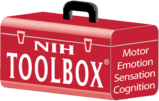
NIH Toolbox App Provides Access to Tests for Cognition, Motor, Sensation and Emotion
Tool may help improve patient care with access to tests for everything from dementia risk to academic screening

An iPad app developed by Northwestern Medicine investigators that helps measure specific aspects of cognitive, motor, sensory and emotional function in five minutes or less is now available for doctors to screen people ages 3 to 85+ for a wide range of neurological diseases and syndromes.
Using the NIH Toolbox® V3 iPad App, time-strapped clinicians are able to assess quickly, yet thoroughly, everything from young children who need screening ahead of school to determine special needs or accommodations to older adults who may be concerned about dementia.
The app is now available in the Apple App Store. Watch this overview video to see the app in action.
“The problem in clinical care today is nobody has time for long tests for everything; we need very brief tests,” said Richard Gershon, PhD, vice chair for research in the Department of Medical Social Sciences, who has led this project.
While some clinical screening tools require expensive custom hardware, this app allows anyone with an iPad to access the full assessment suite: more than 50 tests spanning four domains: cognition, motor, sensation (hearing, smell, pain, vision and taste) and emotion.
A group of tests that would have otherwise taken two to three hours to complete can now be reliably done in under 30 minutes.
COVID-19 patients complaining of “brain fog,” for instance, can now take several brief tests to determine what areas could be the target for cognitive rehabilitation. Or someone who has recently lost their sense of smell can take the Toolbox’s olfactory test (and other Toolbox tests as needed) to better understand if it could be an early sign of Parkinson’s disease.
“Parts of the Toolbox are already being used at Northwestern to detect dementia,” said NIH Toolbox product manager Julie Hook, PhD, MBA, research associate professor of Medical Social Sciences. “Northwestern researchers are also working to develop a self-administered version of these tests that can be taken in the waiting room right before their visit and with the results sent straight into their electronic health record.”
One example of a test to measure episodic memory is a series of pictures displayed on the screen describing a trip to the park, Hook said. After they’ve been scrambled, the patient would have to put the pictures back in order.
Still to come is a Baby NIH Toolbox that will be able to assess the cognitive functioning of babies between one and 42 months old. This age group is currently understudied because of a lack of measures in this age range, Gershon said.
Originally intended as a research tool
The NIH Toolbox was first launched as a website in 2012 and then a more portable iPad app in 2015. While the newest version (V3) is validated for clinical use, it was originally intended solely for researchers to help quickly and inexpensively collect standardized data and boost study enrollment. Physician-scientists and psychologists using the app found it so helpful, they increasingly began to ask if and when it would be released for clinical use.
Now that it is, Gershon and Hook said they believe it will help improve patient care by allowing access to a wide variety of tests that can be easily administered. For example, if an older adult presented to their neurologist with complaints of cognitive decline, the examiner could assess the patient’s cognitive abilities as well as emotional functioning (e.g., depression and anxiety), which can also contribute to those complaints. Similarly, if a student was being assessed by a school psychologist for academic issues, the school psychologist could assess vision and hearing to see if those may be contributing factors to the cognitive-related complaints.
Led by Gershon and his team, the NIH Toolbox was developed by more than 250 scientists over six years and sponsored by the 15 institutes of the National Institutes for Health (NIH) that make up the NIH Neuroscience Blueprint. It allows researchers to assess function using a common metric among measures essential to the process of pooling data and often necessary when a large and diverse sample is needed.
Toolbox currently used by 3,000 researchers
Because the app is distributed through the Apple App store, Gershon and his colleagues don’t always know everyone who is using the Toolbox, but they track analytics detailing how often and where it’s purchased (currently in 21 countries).
The earlier version of the app (V2) has been used by 3,000 researchers from 1,200 institutions globally and has been validated in 300 separate validation studies. The Environmental Influences on Child Health Outcomes, for instance, is an ongoing study examining the impact of a range of early environmental influences on child development and health. There also are numerous Northwestern scientists using the Toolbox, including to assess patients with long COVID.
“The NIH Toolbox cognitive tests are extremely useful for testing the cognitive function of our Neuro-COVID-19 clinic patients complaining of ‘brain fog,” said Igor Koralnik, MD, chief of Neuro-infectious Disease and Global Neurology in the Department of Neurology. “The results are adjusted according to age, education and other demographics, allowing us to tell our patients immediately of their performance, and if they may benefit from cognitive rehabilitation.”
Additionally, a Northwestern-led National Institute on Aging cohort study examining midlife determinants of later-life cognitive decline and dementia uses the Toolbox to readily capture a range of cognitive abilities.
“Patients find the tests easy to use and are more engaged than with other standard measures we have deployed previously,” said principal investigator Michael Wolf, PhD, MPH, associate vice chair for research in the Department of Medicine at Feinberg. “Overall, this is an incredibly important research assessment tool that will help our work be more translatable to other studies.”
More about V3 of the app
The app is available in both English and Spanish languages. Hebrew and Arabic versions will be released later this year. Additionally, numerous studies in Africa use the Toolbox and incorporate a translation app to communicate with Swahili, Dholuo and Twi speakers.
The app is normed to the 2020 U.S. Census, meaning it’s representative of the U.S. population’s race, ethnicity and age. It has improved accessibility for those with disabilities (e.g. high-contrast type for visually impaired people) and automatically scores and stores the results within the app. Lastly, the app decreases the chances of human error during administration for many tests by providing audio instructions for the test takers.
Many of the streamlined tests are accomplished through computer adaptive testing—Gershon’s expertise. In this approach, the app is constantly adjusting the questions to meet the level of the person being tested, eliminating extraneous questions.
“We zero in on that person’s individual level of functioning and don’t waste their time asking questions far above or below their ability,” Gershon said.
This project is supported by federal funds from the NIH Blueprint for Neuroscience Research and the Office of Behavioral and Social Sciences Research, National Institutes of Health, under Contract No. HHS-N-260-2006-00007-C.
